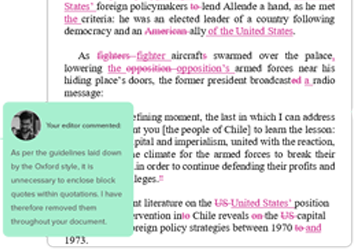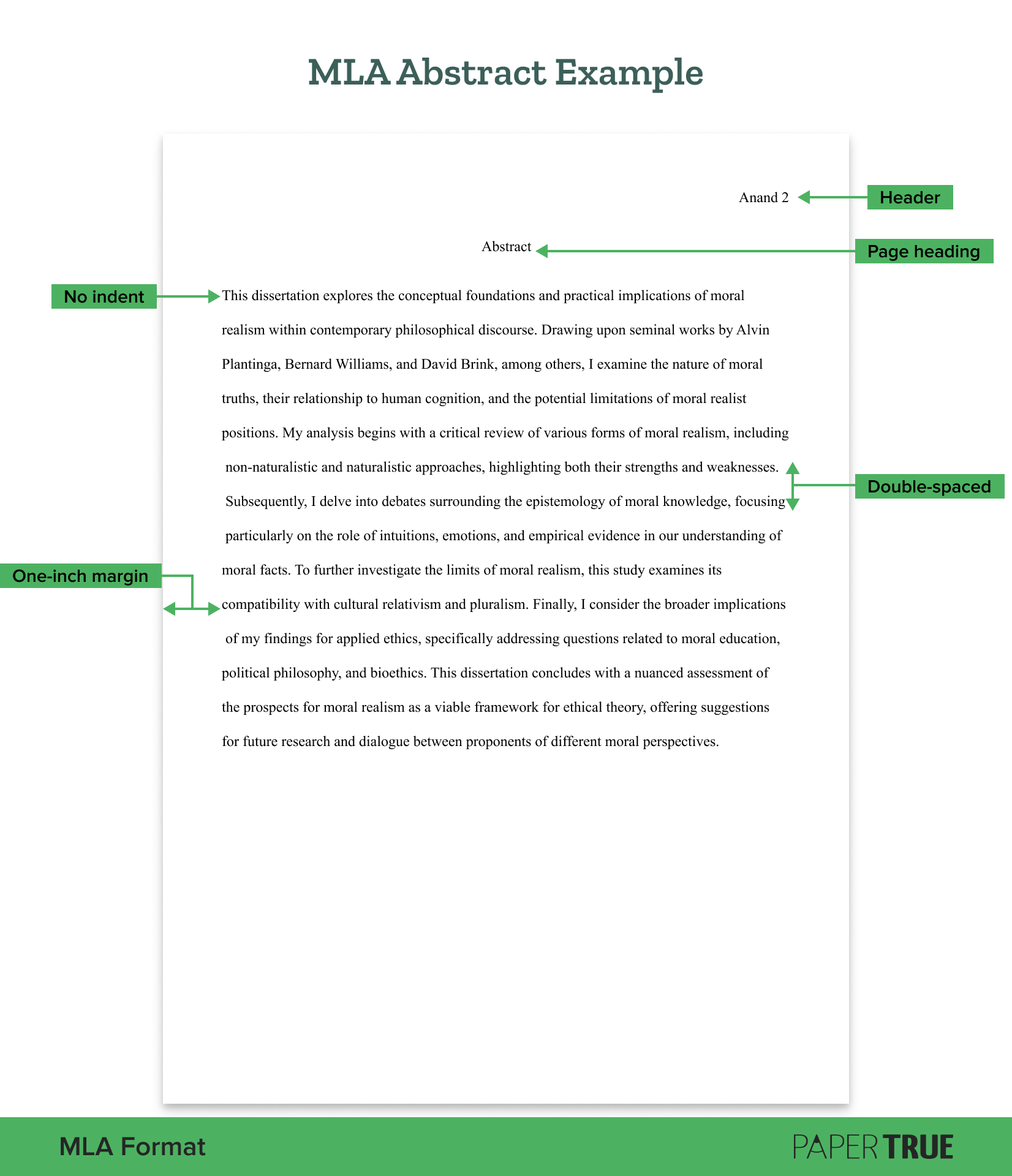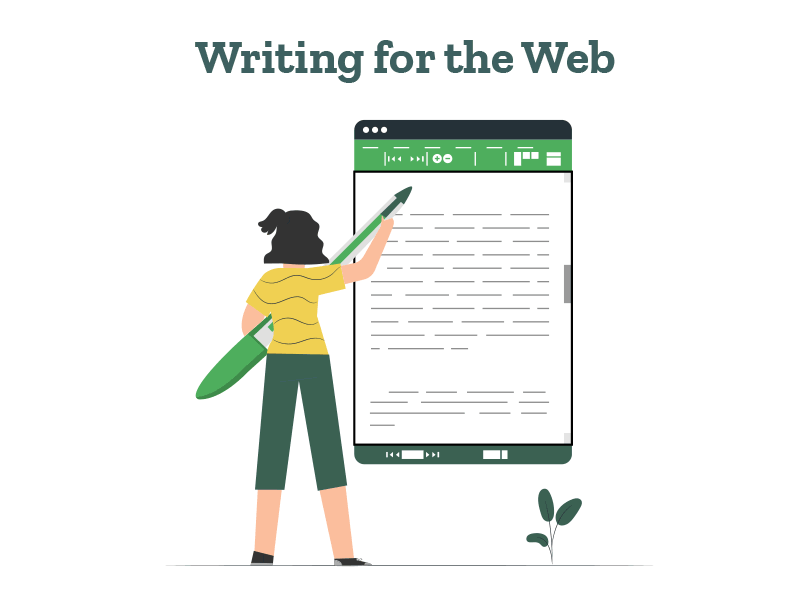Still have questions? Leave a comment

Checklist: Dissertation Proposal
Enter your email id to get the downloadable right in your inbox!

Examples: Edited Papers
Enter your email id to get the downloadable right in your inbox!
Need
Editing and
Proofreading Services?

How to Write an Abstract in MLA Format: Tips & Examples
 Mar 14, 2024
Mar 14, 2024 7
min read
7
min read
- Tags: Formatting Guidelines, MLA, MLA Style
If you’re confused about how to write an abstract in the MLA format, you’re not alone. Since the MLA Handbook doesn’t mention concrete abstract formatting guidelines, students are often unsure about this. That ends today because we’ve compiled a complete guide to the MLA abstract format.
We’ll tell you how to format an abstract in MLA style and what to include while writing it. If any confusion lingers, we have some MLA abstract examples to clear things up. Let’s begin with a hint, though: Always pay attention to your university, department, or course formatting guidelines!
What is an MLA format abstract?
An MLA format abstract is a concise summary of an academic work that mentions its key elements, helping readers scan through the findings. It’s sort of a trailer for academic texts: Researchers can read through the abstract to find out if a work is relevant to their research.
For this reason, an abstract should be brief and include keywords. But you can achieve this in two ways:
1. Informative abstract: Summarizes the background, major points, research methodology, results, conclusions, and recommendations. Typically around 250 words in length.
2. Descriptive abstract: A brief overview of your document without results, conclusions, or recommendations. Typically around 100 words in length.
Does the MLA format have an abstract?
No, MLA format doesn’t typically have an abstract, especially for shorter works like essays and research papers. In the case of longer documents like dissertations or academic books, the writers can use independently established guidelines. As a student, you should refer to the department’s formatting guidelines or check with your instructor.
There’s a reason MLA format papers and essays don’t usually have an abstract. Since MLA format is mostly used in humanities, there are few data points and methodology details to summarize. The focus is on the text itself and how it explores the topic.
If you’re asked to write an abstract, however, you should know why it’s important.
Why is an abstract important?
An abstract is important because it helps students and researchers decide whether your work can be of use to them. A well-written abstract reveals the full scope of your paper or thesis. Abstracts are also accessible to a wide audience while the rest of your work may be behind a paywall. So, an abstract is a way for you to reach a broader readership.
More importantly, abstracts are commonly used by databases and search engines to index and categorize academic research. So, a keyword-friendly MLA format abstract (with help from some academic SEO practices) can make your work easy to discover.
So, let’s find out how to format an abstract in MLA style.
MLA abstract format guidelines
Here are the formatting guidelines for an MLA abstract page:
- Place the abstract page after the MLA title page (unless instructed otherwise).
- Maintain a one-inch margin on all sides.
- Add an MLA header (last name and page number) in the upper right corner.
- Double-space all text on the page.
- Use an 11- to 13-point standard font (Times New Roman, Arial, Georgia, or Calibri).
- At the top of the page, add the heading “Abstract” and center it.
- Don’t indent the first line.
- Ideally, write the entire abstract as a single paragraph.
- Italicize the names of other works mentioned such as books, movies, and TV shows.
- Spell out any acronyms when mentioning them for the first time.
Can’t quite picture it? Let’s remedy that! Here’s an abstract example in MLA format:
MLA style allows a lot of flexibility with these guidelines, so there aren’t many hard-and-fast rules. For example, there are no rules in the MLA Handbook about how keywords should be placed after the abstract. So if you’re asked to include them on your abstract page, you should check the university or department guidelines.
When in doubt, consult with your instructor about how to format an element on the abstract page. Professional researchers can rely on the journal’s or publication’s formatting guidelines.
Now that you know the MLA abstract format, you should learn how to write an impactful one. If your abstract is uninspiring or vague, you can lose out on some readers and some potential citations for your work!
How to write an abstract in MLA format
Here are some tips on how to write an abstract in MLA style:
- Write your MLA abstract after you’re done with the entire paper or thesis, so it’s comprehensive and has no blind spots. Your thesis and methods will evolve as your research progresses, so an abstract written after its completion is more authoritative.
- Keep the abstract brief. About 100–300 words are sufficient.
- Use straightforward language that’s easy to understand; avoid using jargon for the sake of it.
- Summarize the main points of your work, including the thesis statement, methodology, key arguments, major findings, and discussion. If you find this difficult, you can take a gradual approach. Start by writing a rough summary, condensing each section into 1–3 sentences. Then, shorten this further until you’re left with 5–7 sentences.
- Begin your abstract by clearly stating your research question or objective.
- Provide brief background information, but only if it’s essential for understanding the thesis statement.
- Mention only the most important details about your research methodology or approach.
- Present your key findings in brief, emphasizing their implications.
- Highlight your contribution to your subject through the research, but don’t exaggerate any findings.
- Get feedback from classmates and edit the abstract accordingly.
- Check whether you’ve kept the formatting consistent with the rest of the document.
- Proofread the abstract once last time when you’re done.
While writing an abstract in MLA format, you may not have a concrete methodology or data points. This is especially true for courses like literature. In that case, you simply have to present an overview of your process. Briefly mention the framework or approach with which you analyzed an artwork and your findings.
Plus, the space of 5–7 sentences doesn’t leave much room for ambiguities. So, keep your MLA abstract crisp, interesting, and easy to understand. If you need help ensuring this, our paper editing services have got you covered!
Sample MLA abstract
The MLA abstract example we saw above highlighted the formatting guidelines. Now, let’s take a look at the details an abstract should include.
a.Thesis statement
b.Methodology
c. Argument
d. Findings
e. Discussion/recommendation
Abstract
This critical analysis asserts that contemporary Caribbean authors challenge and redefine Western literary paradigms by interrogating notions of identity. By examining works such as Marlon James’ A Brief History of Seven Killings (2014) and Nalo Hopkinson’s Brown Girl in the Ring (1998), this study demonstrates how these writers decolonize the canonical gaze through their innovative use of language, genre, and narrative structure. The paper argues that these texts employ subversive strategies to disrupt colonial narratives and center marginalized voices, thereby critiquing neocolonial power structures. These literary interventions are significant within broader discussions about postcolonial theory, cultural hybridity, and diasporic identities. This exploration complicates the notion of identity and invites further research into the role of literature in relation to social networks of power, both within the Caribbean region and in global contexts.
This sample concludes everything there is to know about writing an abstract in MLA format. If you’d like to keep reading about academic writing and formatting, here are some resources:
- Research Paper Format: APA, MLA, & Chicago Style
- How to Write an Essay Header: MLA and APA Essay Headers
- MLA Citation Examples: Cite Essays, Websites, Movies & More
- Citing References: APA, MLA, and Chicago
- How to Write a Research Paper: A Step-by-Step Guide
- MLA Works Cited Page: Quick Tips & Examples







